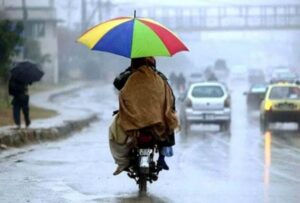The Pakistan Meteorological Department (PMD) has predicted widespread rain and snowfall across the country from March 2 to 4. The Punjab, Khyber Pakhtunkhwa, Balochistan, and Sindh states are expected to experience moderate to heavy rainfall as a strong western weather system moves into Pakistan. Northern areas, including Murree, Galiyat, and the higher altitudes of Gilgit-Baltistan and Azad Jammu & Kashmir, are likely to experience significant snowfall, which could disrupt travel and daily life.
Authorities have advised residents in mountainous areas to take precautions against potential road blockages and landslides. Rain is expected to bring much-needed relief from dry conditions in urban centers, improving air quality but also increasing the risk of localized flooding in some areas. Farmers should take the necessary precautions to shield crops from excessive rainfall. The PMD has urged citizens to stay updated with weather forecasts and exercise caution, especially in regions prone to heavy downpours and snowfall. Travelers should check road conditions before planning trips to affected areas.
Overview
This section introduces the topic, providing the reader with an overview of the weather forecast, which predicts significant rainfall and snowfall across Pakistan from March 2-4. You’ll begin by highlighting the importance of such weather events and the relevance of the forecast to the broader public. This introduction will set the stage for the detailed exploration of the weather patterns, impacts, and responses.

- Importance of Weather Forecasts: Discuss the significance of weather forecasts in modern-day life, particularly in a country like Pakistan, where weather patterns significantly affect the agricultural sector, economy, and daily life.
- Overview of the Expected Weather: Briefly mention the expected rainfall and snowfall from March 2-4, referencing any official meteorological bodies like the Pakistan Meteorological Department (PMD).
- Why March 2-4 is Critical: Explain the significance of these dates, considering the seasonal transition between winter and spring in Pakistan. March marks the end of winter, and any late-season snowfall or rain can be unusual but impactful.
Meteorological Factors Behind the Forecast
In this section, you will explain the scientific and meteorological reasons for the expected rains and snowfall from March 2 to 4. The readers should understand why such weather patterns are predicted and how they form.
- Low-Pressure Systems and Weather Fronts: Discuss the role of low-pressure systems, cyclonic activity, or weather fronts moving across the region that lead to precipitation.
- Western Disturbances: Explain the concept of western disturbances, which are familiar sources of late-season snowfall and rainfall in Pakistan. How do these disturbances interact with the region’s topography to bring such weather conditions?
- Cold Air Masses and Atmospheric Instability: Discuss how cold air masses combined with warmer, moist air lead to precipitation events.
- Historical Precedents: Mention any historical events in which similar weather patterns occurred around the same time of the year.
The Role of the Western Disturbance in Pakistan’s Weather
Western disturbances play a crucial role in bringing rainfall and snowfall during the winter and early spring months. This section focuses entirely on the mechanics of these disturbances.
- What is a Western Disturbance?: Provide a detailed explanation of Western disturbances, their origin, and their movement across Pakistan.
- Impact on Various Regions: Highlight the areas most affected by western disturbances, such as the northern areas (Murree, Gilgit-Baltistan), the west and central regions (Baluchistan, Khyber Pakhtunkhwa), and some parts of Punjab.
- Winter vs. Spring Weather: Discuss the transition of weather from winter to spring due to the western disturbances and how this impacts seasonal rainfall and snowfall.
- Forecasting Challenges: Address the challenges meteorologists face when predicting the timing, intensity, and geographical impact of these disturbances.
Regional Impacts of the March 2-4 Weather Event
This section focuses on the anticipated regional effects of rainfall and snowfall in Pakistan, dividing it into different geographical regions.
- Northern Pakistan (Gilgit-Baltistan, Khyber Pakhtunkhwa): Describe the expected snowfall in the northern mountainous areas, which often see heavy snow during this period.
- Islamabad and Rawalpindi: Forecast the impact on urban centers like Islamabad and Rawalpindi, which often experience rainfall during such disturbances. Discuss expected temperatures, road closures, or any expected disruption in daily life.
- Punjab and Sindh: Explain how the plains of Punjab and parts of Sindh will be affected by rainfall, including agricultural implications, road conditions, and possible flooding risks.
- Baluchistan: Focus on Baluchistan, which is known for its dry climate but can experience sudden rainfall due to western disturbances. Mention expected rain patterns and their impact on this arid region.
Agricultural Implications of the March 2-4 Rains and Snowfall

Rainfall and snowfall significantly impact Pakistan’s agriculture. This section focuses on how the expected weather will affect the agricultural sector.
- Impact on Crops: Discuss how the rains will benefit certain crops, especially in the wheat-producing areas of Punjab, and how snowfall will affect the overall water availability for irrigation. The water stored in glaciers and snowcaps is crucial for crop production.
- Potential Damage to Crops: Heavy rainfall can also lead to waterlogging, which can damage crops like cotton or vegetables. Highlight any possible risks to sensitive crops.
- Soil Erosion and Landslides: In mountainous regions where heavy rainfall is expected, such as in Khyber Pakhtunkhwa and Gilgit-Baltistan, explain the risks of soil erosion and landslides, which can lead to significant agricultural losses.
Snowfall and Its Impact on Tourism in Northern Pakistan
Northern Pakistan, with its picturesque valleys and snow-capped mountains, attracts tourists year-round, especially in winter. This section will discuss the impact of the expected snowfall on tourism.
- Tourism in Gilgit-Baltistan and Murree: Explain how snowfall impacts tourism in the northern tourist hotspots, such as Murree, Hunza, Swat, and Naran Kaghan. This can include a discussion of tourists’ safety, road accessibility, and the appeal of the snow-covered landscapes.
- Winter Sports and Activities: Some regions in the north, like Skardu, have skiing resorts and are popular for snow-related activities. Discuss how these activities will be affected or enhanced by the March 2-4 snowfall.
- Tourism Sector Challenges: On the downside, discuss how heavy snowfall can cause road closures, transportation issues, and even accidents that can hinder tourism activities.
Challenges for Urban and Rural Infrastructure During the Weather Event
The infrastructure of both urban and rural areas faces various challenges when dealing with heavy rainfall and snowfall. This section will delve into these issues.
- Urban Flooding and Drainage: Cities like Islamabad, Rawalpindi, and Lahore are prone to urban flooding due to poor drainage systems. Discuss how heavy rains could disrupt traffic, cause road blockages, and affect daily routines in significant cities.
- Power Outages: Snowfall and rain can damage power lines, leading to outages. Discuss the potential impact on power grids, especially in mountainous regions where access to repair teams may be delayed.
- Rural Accessibility: Snowfall can disrupt transportation and make remote villages inaccessible in rural areas, particularly in mountainous regions like Gilgit-Baltistan. Highlight how this can impact daily life, food supply, and emergency services.
Safety Measures and Preparedness for the Weather Event

This section will discuss how the government, local authorities, and citizens can prepare for the expected weather events.
- Government Warning Systems: Explain the role of the Pakistan Meteorological Department in issuing warnings and how the government uses this data to alert citizens.
- Emergency Response Plans: Highlight the safety measures taken by local authorities, including road clearances, snow removal, and emergency shelters for those affected by heavy snowfall.
- Public Awareness Campaigns: Discuss the importance of educating citizens on how to stay safe during heavy rains and snowstorms, including tips on avoiding flooded areas, staying warm during snowfall, and preparing emergency kits.
Environmental Impact of the March 2-4 Weather Events
Weather events like rainfall and snowfall affect human life and have significant environmental consequences. This section will discuss the broader environmental impact.
- Water Resources: Snowfall in mountainous regions is essential for replenishing water resources, especially in areas like Gilgit-Baltistan, where glaciers provide critical water for irrigation and hydropower.
- Ecosystem Effects: The sudden change in weather patterns could disrupt local ecosystems, particularly in the northern regions, where plants and wildlife are adapted to specific weather conditions. Discuss how changing precipitation patterns might impact local flora and fauna.
- Impact on Glaciers: Discuss how late-season snowfall contributes to glacier health, especially in the Karakoram and Himalayas, and its implications for long-term water supply and climate patterns.
Reflecting on the National Impact of the Weather Event
In the final section, provide a reflective analysis of the weather event’s potential long-term impacts, summarizing the key points discussed in the article.
- A National Perspective: Emphasize the event’s national scope, considering how it affects different regions and sectors in different ways.
- Long-Term Impact on Climate Change: Reflect on how such weather events may fit into broader trends of climate variability and change.
- Future Preparedness: Conclude with thoughts on how Pakistan can improve its preparedness for extreme weather events in the future, particularly in light of global climate change and increasing unpredictability in weather patterns.
Expanding the Content
To reach your target word count, you can:
- Add real-time data from weather reports and predictions.
- Include quotes from meteorologists, government officials, and affected citizens.
- Discuss case studies from past years when similar weather events occurred in Pakistan.
- Incorporate relevant statistics, historical data, and environmental research.
Frequently Asked Questions
Which areas will receive rain and snowfall?
Most regions, including Punjab, KP, Balochistan, Sindh, and northern areas, will experience rain, while snowfall is expected in hilly areas.
What is causing this weather change?
A strong westerly system is bringing rain and snowfall across Pakistan.
When will the rains and snowfall begin?
The system will be active from March 2 to March 4.
Will major cities be affected?
Yes, cities like Islamabad, Lahore, Karachi, and Quetta may experience rainfall.
Which areas will get the heaviest snowfall?
Murree, Galiyat, Gilgit-Baltistan, and Azad Jammu & Kashmir will see significant snowfall.
Are there any risks of flooding?
Urban flooding is possible in low-lying areas due to heavy rain.
Will travel be affected?
Yes, snowfall may cause road blockages in northern regions.
How will this impact farmers?
Excessive rain may affect wheat and other seasonal crops.
What precautions should residents take?
Stay updated on forecasts, avoid unnecessary travel, and prepare for potential disruptions.
Will temperatures drop due to this system?
Yes, temperatures are expected to decrease across many regions.
Conclusion
The upcoming spell of rain and snowfall from March 2 to 4 is expected to impact various parts of Pakistan. While the precipitation will provide relief from dry conditions, it also poses risks such as urban flooding, road closures, and landslides in mountainous regions. Travelers and residents in affected areas should take necessary precautions.
Authorities advise farmers to protect crops from excessive rainfall, while travelers heading to northern areas should check road conditions beforehand. The Pakistan Meteorological Department (PMD) continues to monitor the situation and urges citizens to stay informed through official weather updates.

